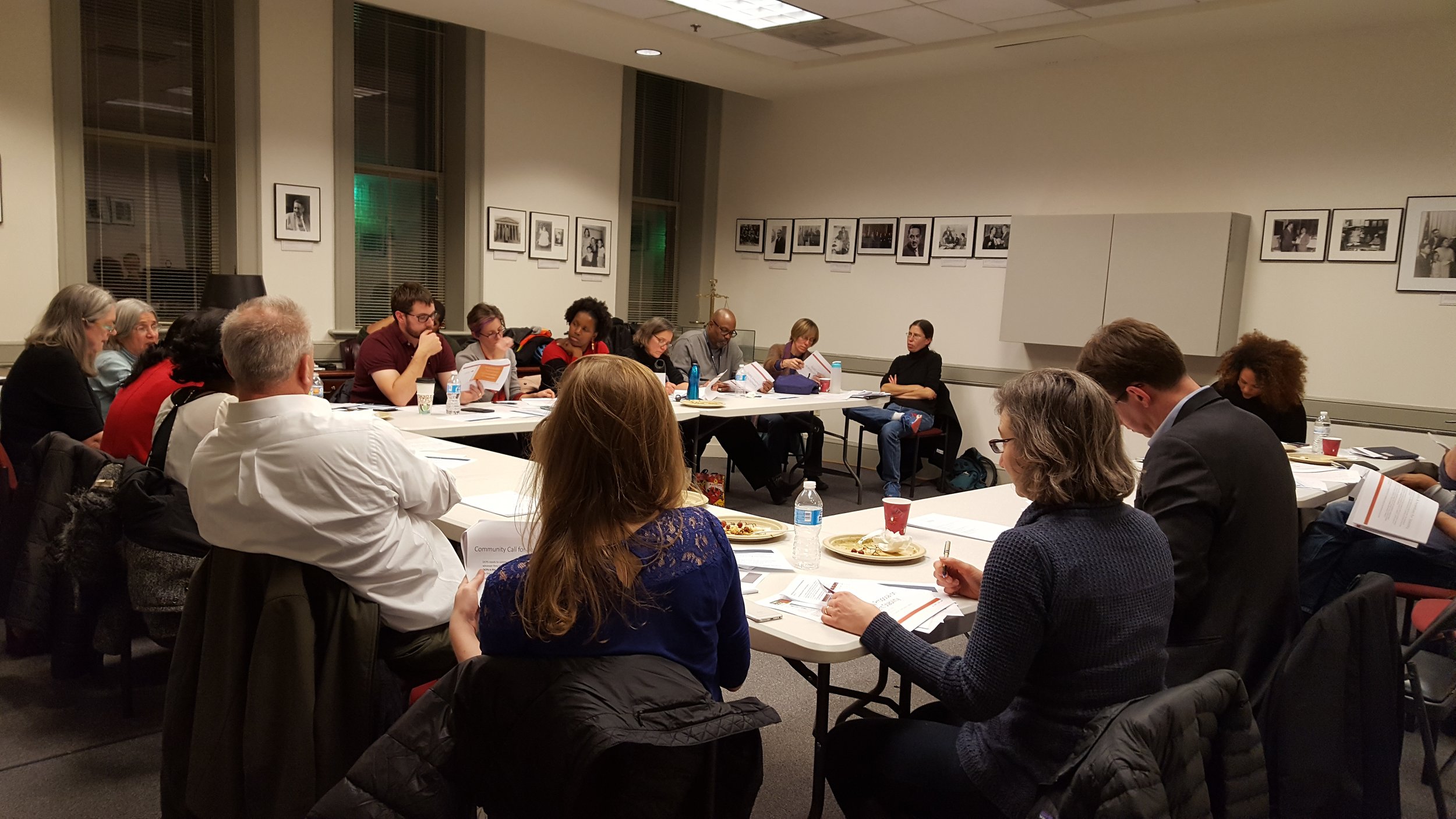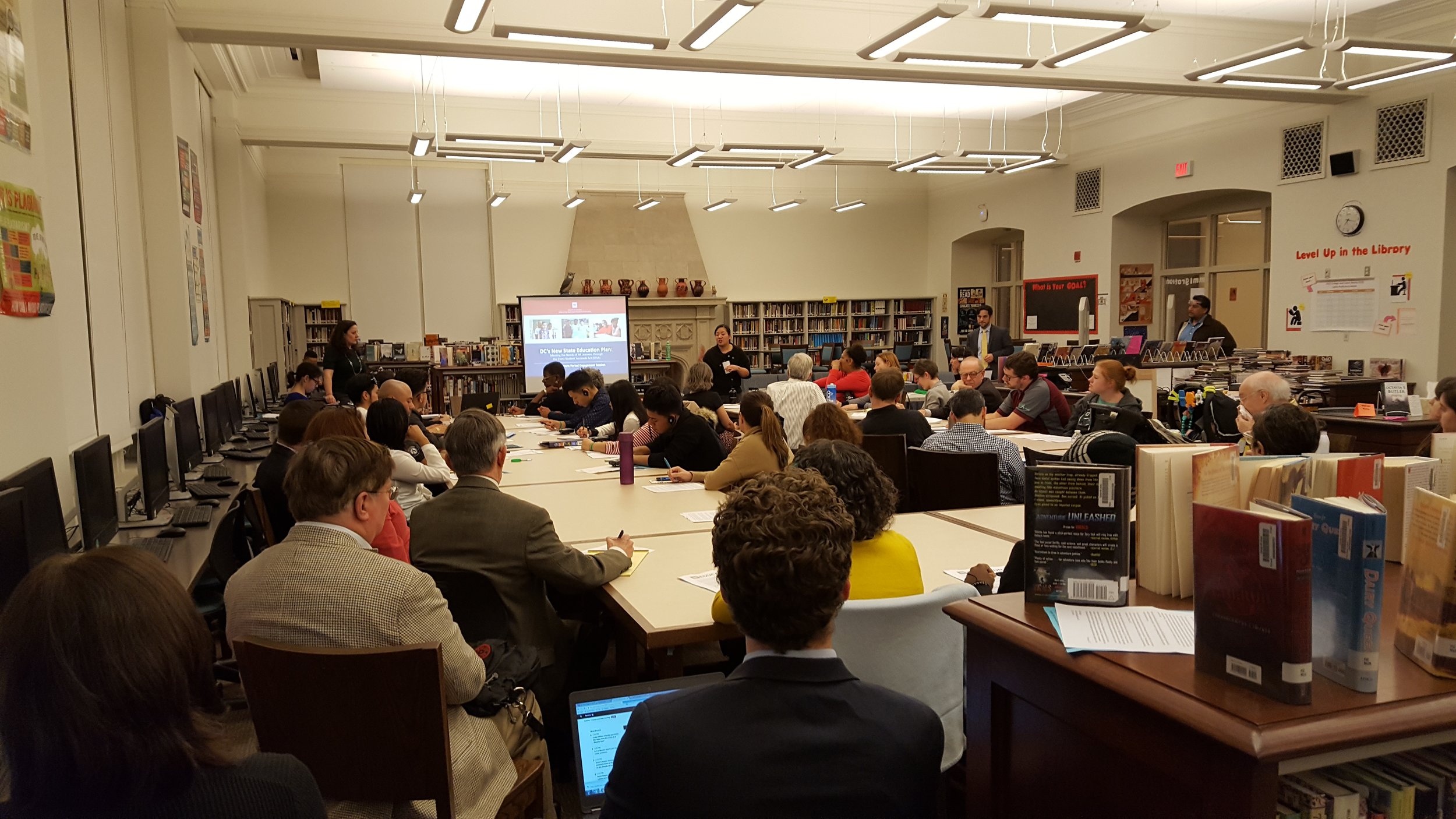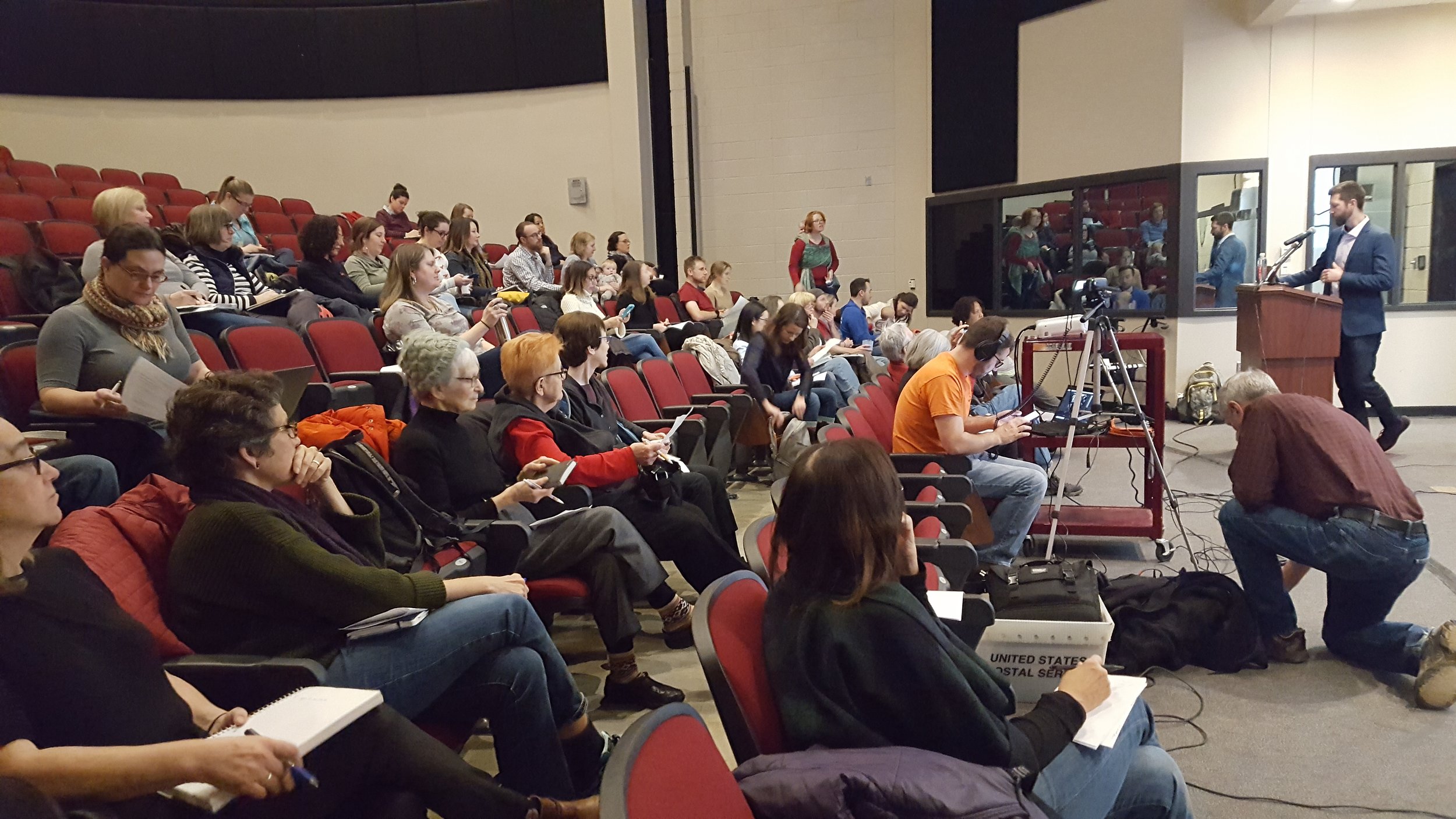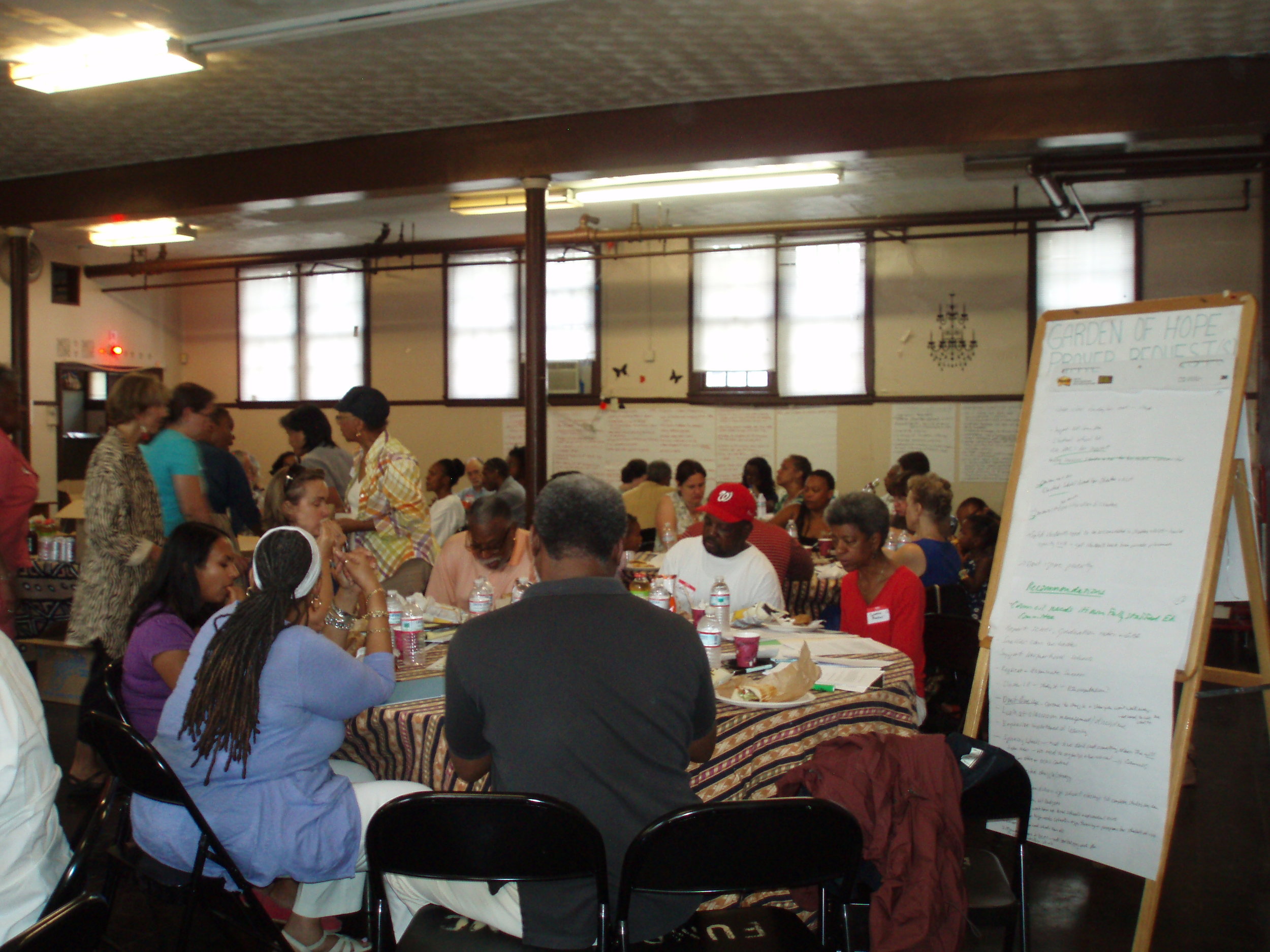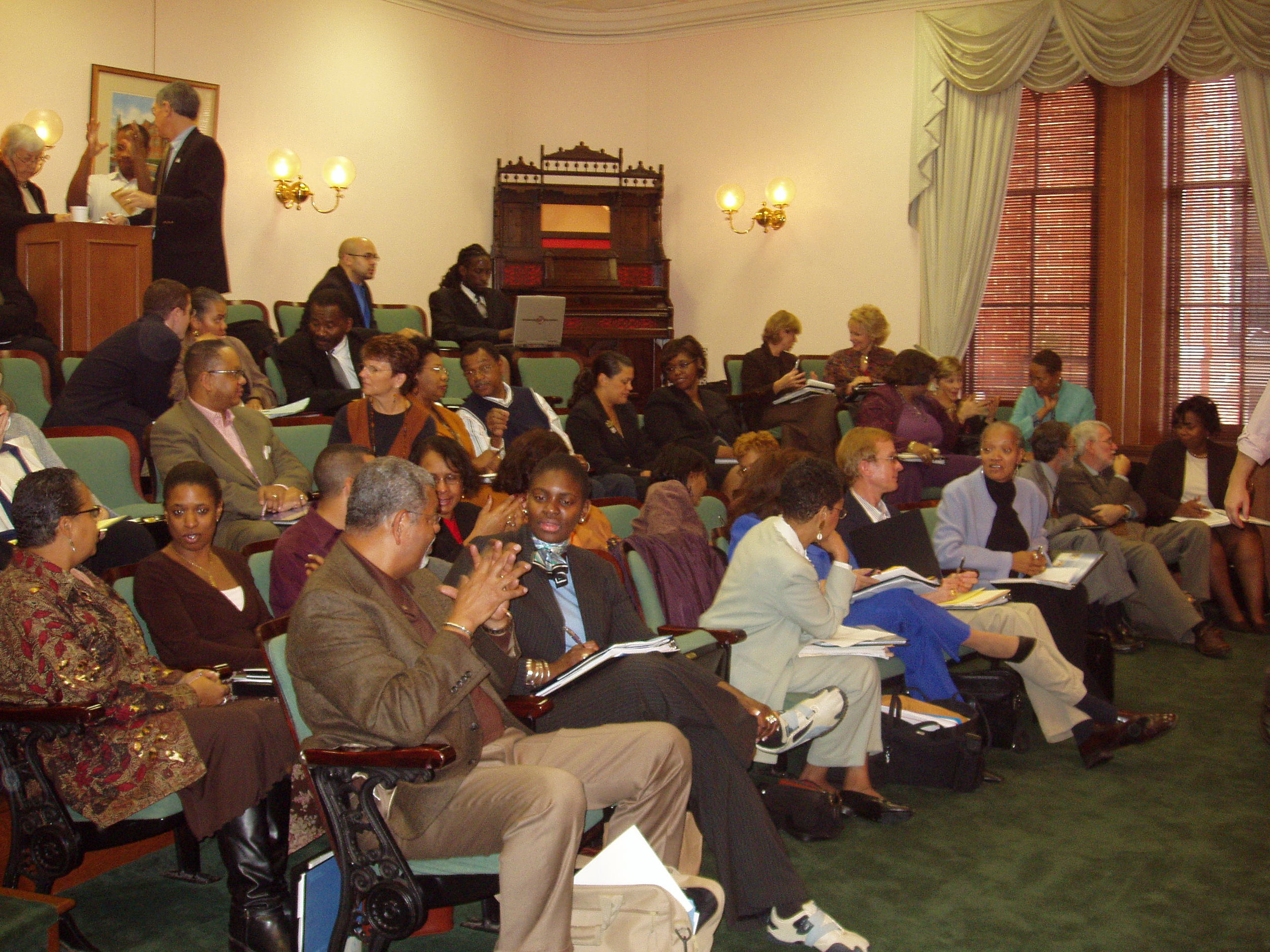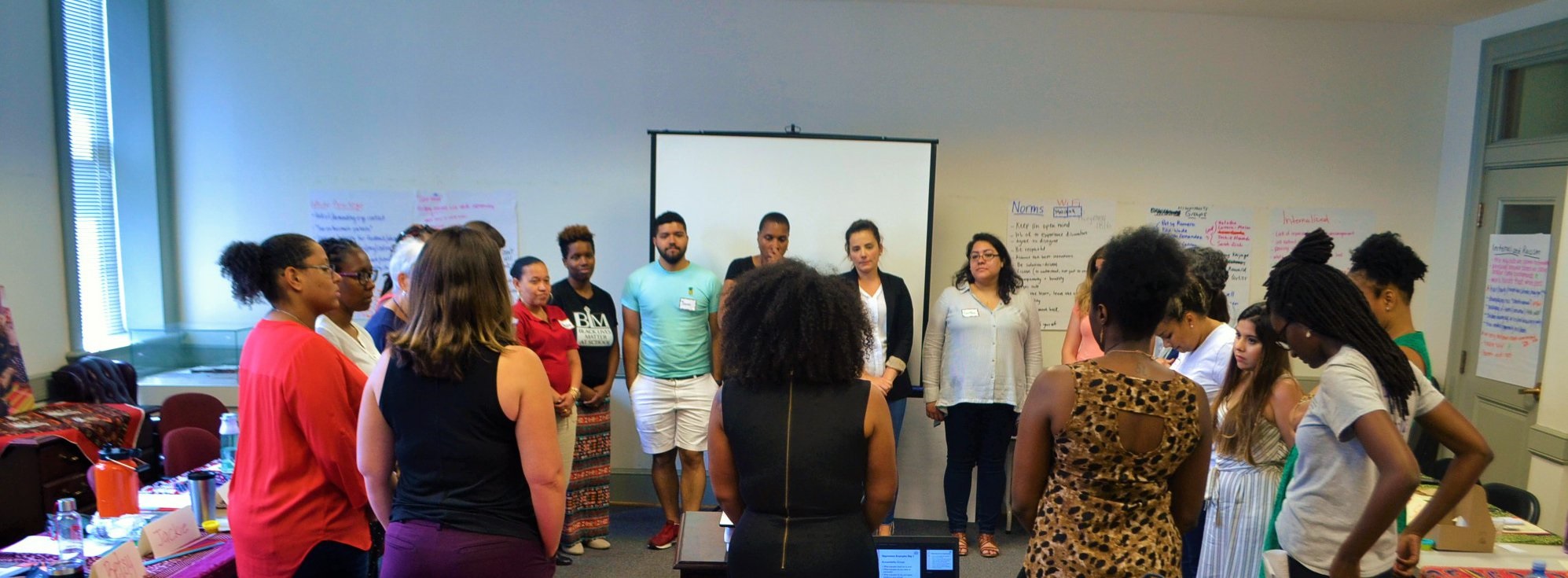Testimony of the WLC on Civil Rights and Urban Affairs on FY23 Budget
/Testimony of the Washington Lawyers’ Committee for Civil Rights and Urban Affairs
School Budget Oversight Hearing Before the Committee of the Whole of the Council of the District of Columbia
March 28, 2022
The Washington Lawyers’ Committee for Civil Rights and Urban Affairs urges the Council to redouble efforts to reverse the effects of generations of systemic racial discrimination and poverty, and to invest in a racially just education system in DC. The legacy of a segregated and unequal education system is still the reality for many parents and students today: Black and Latino students in DC are more likely to attend public schools that are under-resourced, outdated, and over-policed.
The ongoing COVID-19 pandemic has meant two years of traumatic and unpredictable challenges for our students, staff and parents, and our school communities have shown tremendous resilience and resourcefulness. Nevertheless, during the pandemic, literacy rates of Black and Brown students and those in poverty dropped and the literacy gap between students of color and white students widened.[1] Our neighborhood public schools, in particular, deserve as much support as the District can afford to assist students and entire school communities to continue to recover from those challenges and really begin to thrive.
The pandemic’s challenges demonstrated that the health of our neighborhood public schools are central to the health and well-being of our communities. In addition to being places of learning, relationship-building, and democratic participation, they also function as community centers providing food, health care and other wrap around services to families. DC’s budget choices must support the full recovery of our students, schools, and their communities so that they can flourish.
The recommendations below prioritize investing in students who are most in need and who have been most harmed by the District’s failure to fully invest in them: students of color, students with disabilities, and students who are in poverty. In particular, we recommend that the Council:
· Provide additional funding for DCPS schools to ensure that no school needs to cut critical staff and programming, and invest in DCPS’s neighborhood and feeder schools that serve students and communities that have been deprioritized in prior budgets
· Create digital equity by ensuring that students and teachers have the devices, infrastructure and training necessary for their work
· Defund police in school, and invest in evidenced-based best practice school-based strategies that promote public safety and an equitable leaning environment, including mental, behavioral, and physical health services, enrichment and community building programs, non-punitive conflict resolution training for staff and students, and restorative justice
· Designate funds to compensate students with disabilities for special education and related services lost during the pandemic.
The Mayor’s Proposed Funding for DCPS Title I Schools in Underserved Areas is Not Enough To Meet Rising Costs & School Community Needs.
We appreciate that the Mayor’s proposed budget increases the UPSFF by 5.87 percent, from $11,730 to $12,419 per student and adds $36 million to support DCPS and charter schools that had enrollment declines, but because so many schools are being cut significant amounts, it is uncertain whether that will be nearly enough to meet the needs of each school.
However, the proposed 5.87 percent increase will likely leave most schools short of the funding for full staffing and programming needed to support students for the entire 2022-2023 school year. Sixty percent of DCPS proposed school budgets do not keep up with real costs. DC Fiscal Policy Institute found that 73 DCPS schools have FY 2023 initial budgets that would not keep up with FY 2023 costs; the average real costs gap across all 73 schools is nearly $270,000.
The proposed budget cuts are disproportionately affecting schools serving majority students of color. Forty percent of the schools that are losing funding are in Wards 7 and 8, where the combination of divestment in communities and housing unaffordability is contributing to enrollment declines in neighborhood schools East of the Anacostia River. Another 21 percent of the schools are in Ward 4. Schools with budgets that would not keep up with FY 2023 costs and inflation are concentrated in Wards 4, 6, 7, and 8.[2]
Fifty-eight schools are projected to receive less total funding dollars than last school year, and another fifteen schools will receive less funding after accounting for increases in salaries and other real costs. While many school enrollments may be down, this does not account for this reduction in funding. First, some of the schools facing budget cuts are actually projected to gain students. Second, even if projected enrollment is lower, most DCPS schools are not projected to lose enough students to warrant eliminating a class at any level, or any teachers or other staff, for that matter. Yet, according to D.C. Fiscal Policy Institute, across all 58 schools that are losing funding, the average gap between schools’ FY 2023 initial budget and FY 2022 submitted budget is $242,193. That is the equivalent of two full-time teachers. 25 schools have funding cuts that are much higher – in the $300,000 to $500,000 range.
The Washington Lawyers’ Committee for Civil Rights coordinates the School Partnership Program, where about 60 area law firms are paired with DCPS Title 1 schools to provide support, mentoring, tutoring, and other services. The partnerships also offer unique insight into the needs of the school communities, and how they are impacted by these proposed budget cuts. Schools are reporting that under the proposed budget, they will need to make unwanted staff reductions, despite an ongoing need to fully staff their schools. For example:
· A Ward 6 elementary school will lose an ELL teacher next year, which will negatively impact the school’s ability to serve ELL students.
· A Ward 8 elementary school will lose two positions due to budget cuts: a behavioral interventionist and a custodian.
· A Ward 1 elementary school did not have full funding this year for teachers for “specials,” such as science and art. Those specials won’t be fully funded next year under this proposed budget, either. This past school year, the school had to cut needed floating support staff members in order to afford one science teacher.
Because of the failure to provide sufficient base funding to schools, the At Risk, Special Education and English Language Learner funding – which are specifically designed to ensure students most in need of support will have it in their local schools – may be used to meet basic budgetary needs and not enhanced supports. This failure disproportionately impacts students of color, who are mostly likely to be labeled At Risk. Proposed school budgets for next year are still shortchanging students who fall into categories for extra funding. As has been the case for many years, the proposed budget’s base UPSFF funding for schools with higher concentrations of students who fall into At Risk categories is being reduced, and individual schools may have to use significant portions of their At Risk dollars to supplant rather than supplement their UPSFF base funding. This failure to fully fund schools so that At Risk funds can be used for their intended purposes violates the law.[3] In addition, the At Risk weighting still falls short of the 0.37 weighting recommended by the 2013 Adequacy Study and emphasized by the DC Auditor in its 2019 Report that DC schools continue to shortchange students falling into that category.[4]
The Council should make sure DCPS funding provides schools with sufficient general funding to avoid staff and program cuts. It will ensure needed staffing and programming and will reduce, but not eliminate, the amount that schools use from At Risk funding to supplant general funding, which continues to violate the law.
The Districts Needs to Support DCPS Neighborhood Schools and the Feeder Patterns from Elementary Schools through High Schools.
The Council should invest in and prioritize DCPS’s neighborhood schools and feeder patterns. DCPS schools are the publicly governed and managed system of neighborhood, by right, public schools that provide significant benefit to families, communities, and our democracy. Creating and maintaining a well-functioning DCPS citywide system of public education is a powerful tool for advancing access to high quality educational opportunities for all students. The failure to invest in the District’s neighborhood system results in divestment, under enrollment, and school closures that disproportionately impact students of color. For example, the District has closed DCPS neighborhood schools rather than investing in them to deliver the programs, modernizations, and supports that the neighborhood schools required. School closures are concentrated in Wards 5, 7 and 8, where there are so many closed DCPS neighborhood that DCPS has enrollment capacity for only about 50% of the students living in those wards. This loss of a by right option disproportionately affects Black students who make up the majority of students in these neighborhoods.
Currently, investments in education in DC are too thinly spread among DCPS and over sixty charter LEAs, and money is not targeted towards ensuring a high-quality, by-right public education system. The Deputy Mayor for Education repeatedly has told the Public Charter School Board that he is very concerned “that our school system is tipping too heavily towards a large number of unintentionally small schools. Our concern is based on the understanding that resources and facilities are finite, and that in duplicating costs and stretching resources too thin, we are ultimately doing a disservice to our students, families, and existing schools.”[5] Even the PCSB has questioned new charter applicants in recent years whether there really is sufficient demand for yet another charter school in neighborhoods that are becoming saturated with them.[6] For example, in Ward 5, there are now three charter elementary schools (24) for every DCPS elementary school (8). For all K-12 students, there are 41 charter schools and 16 DCPS schools for a total of 57 schools in Ward 5 alone,[7] but they educate just 16,992 students.[8] By contrast, most urban or suburban school districts around the country would have less than half that number of schools to educate the same number of students.[9]
It is particularly important to invest in DCPS because it guarantees an education for every school age child in every neighborhood in the District. As a result, DCPS serves the students that are most likely to be excluded from education, including students of color, students with disabilities, and students who are low-income. Indeed, many DCPS neighborhood schools still have 70 percent or higher concentrations of students in acute poverty as defined in the District’s statutory At Risk categories.[10]
To ensure that funding is not duplicative and can be invested to support students and communities most in need, the District should have a moratorium on opening new charter schools and expanding existing ones, at least until a detailed Master Facilities Plan is developed. That plan should include reasonable parameters for any future growth of school facilities, and address structural inequities in facilities funding that disadvantage DCPS as compared to charter LEAs.[11] The Master Facilities Plan should be created with robust public involvement, and it should functionally guide the plans of both charter and DCPS sectors.
Consistent with that approach, we oppose the recent request by the “DC Students Succeed” organization for a 3.1 percent increase in the facilities allowance for charter schools. The charter sector as a whole does not spend a significant portion of the total annual facilities allowance, which is reflected in the more than $500 million surplus the sector had in reserve in cash, equivalents and investments in 2020 and to which it adds $40-50 million each year.[12] Further, as there is no requirement for the charter schools to actually use their facilities allowance for capital improvements, much of the facilities allowance is either used for operating costs or held in reserve for years.
The District Needs to Prioritize Improving School Facilities East of the River
Students need safe, renovated buildings in which to learn. The money designated to school modernization has favored schools West of the River, and schools East of the River have languished in disrepair. For example, other than the renovation of Winston Education Campus and the citywide enhancement of school HVAC and boiler systems, no capital improvement projects have been included for Ward 7 schools in the FY 2023 budget.[13] The Committee supports the demands from the Wards 7 and 8 Education Councils to fund renovations at schools in Wards 7 and 8.[14]
The $1.5 billion earmarked by the Mayor to modernize DCPS schools last year needs to be prioritized for schools East of the River, as they have not been modernized at the same rate as those West of the River. While there are several schools West of the River that also have been delayed in modernization, the spending should prioritize schools East of the River that have been postponed for years as West of the River schools generally were modernized first and ran up cost overruns. Those cost overruns postponed desperately-needed improvements for so many students of color living in historically underinvested neighborhoods.
Progress on Digital Equity Inside and Outside of Schools Needs to Accelerate
Access to technology, internet, and devices continues to be critical to ensuring equity in education. Over the last year, students have faced quarantines; staffing shortages; and unplanned school closures during which they were dependent on DCPS-provided laptops and internet. But DCPS still does not have enough working laptops for all grade 3-12 students at every school and broadband access, speed, and capacity at many schools is still inconsistent.
We support Digital Equity in DC Education’s repeated demands to District leaders that DCPS provides a 1:1 student-device ratio and a 1:1 teacher-device ratio. This is common among other school districts in the region and some DC charter LEAs.[15] DCPS is not meeting these benchmarks currently, even after increased investments in the 2020 and 2021 budgets. The 2021-2022 DCPS budget provided $13.2 million meant to reach a 1:1 student device ratio for Grades 3-12, but it leaves grades Pre-K to 2 with a 3:1 ratio funded by federal COVID relief funds that are not a permanent solution to this ongoing need.[16]
Despite last year’s investment, not all students have devices. Mentors involved in our School Partnership program, who work with DCPS students and teachers, report that at some schools, even at the middle and high school level, students do not have their own laptops. Instead, their laptops are on carts for classes to share, because there still are not enough working devices for all students.
Students and teachers also rely on technology in the classroom. Regarding Smartboards in particular, this school year’s budget only allocated $1.5 million to refresh Smartboard/audio-visual technology in classrooms, when much more money was needed to provide similar upgrades.[17] DCPS admitted in November 2021 that 3,200 learning spaces are in need of a new interactive board. While DCPS has ordered 545 replacement boards, the rest of the replacements are subject to obtaining additional funding.[18] The proposed school budget for DCPS next year provides for 1,500 additional Smartboards; even if all of those are purchased, delivered and installed in a timely manner, that would still leave another 1,200 classrooms next year without a needed, functioning Smartboard.
DCPS also must have flexibility and capacity to replace broken devices and handle increases in enrollment midyear. Individual school technology leads at several school partnerships schools recommend that schools have at least 5-10% more devices available than their enrollment population at the start of the school year, so they can issue devices quickly to students who arrive mid-year, as well as to quickly swap out working devices for students and teachers who have broken or malfunctioning devices. Under DCPS’s current model, there are not enough devices to handle this need.[19]
Finally, students need to be able to access online school materials at home to research and complete assignments, even when they are not out sick or on quarantine. Their digital access to internet resources outside of school is just as critical as their access inside of school.[20]
The Council should allocate sufficient funding to ensure that DCPS reaches a 1:1 student to device ratio for grades 3-12 and that there is additional funding to support annual replacement of lost, damaged, and out-of-date computers. In addition, appropriate tech devices and tools that meet student needs at every level should be prioritized. For example, the Microsoft Surface Gos generally are not powerful enough for many high school level applications, so we support a comprehensive investment for robust devices at the high school level to meet student coursework requirements for SY2022-23. Funding also must support asset management and technology support: in a DCPS survey of school leaders during the summer of 2021, asset management was the number one item identified for additional support; tech support and asset management can minimize device loss and provide a seamless teaching and learning experience.
In addition to investing sufficient funds in technology, the Council should pass the DCPS Technology Equity Act of 2021, as the comprehensive planning and purchasing it requires will reduce the likelihood that teachers and students will be forced to start each school year without working, functional devices.
The District Must Invest More to Support the Health and Well-Being of D.C. Students
Investing in the mental health and overall wellness of students is tantamount to investing in their academic progress. Many young people in the District have experienced trauma and adverse childhood experiences (ACEs) that are proven to impact students’ mental health and ability to learn.[21] This is particularly evident when considering the District’s Black and Brown young people’s experiences with racism, community violence, and police violence. And, the effects of the pandemic on students’ mental well-being will continue to surface and may do so for years to come, further underscoring the need for a long-term commitment to investing in students’ mental health.[22] In recognizing this, the Committee fully supports the Strengthening Families Through Behavioral Health Coalition’s budget recommendations for the School-Based Behavioral Health Expansion Program.
We acknowledge that the Mayor’s FY2023 budget proposal provides for additional funding for the School-Based Behavioral Health Expansion Program. However, the Mayor’s budget decreases the amount of grant funding for Community Based Organizations (CBO) that provide clinicians for each of the schools. Specifically, the budget proposal reduces these grants from $80,000 to $70,000 per clinician, which will make it impossible for some CBOs to maintain the clinicians they already have in schools. The Department of Behavioral Health (DBH) and the CBO providers should not be expected to provide more services with less money than they received in prior years. The School-Based Behavioral Health Expansion Program is now in its fourth year, and ensuring that these grants remain at $80,000 will stabilize the clinicians that are currently in schools and allow young people to receive the services that they need. We urge the Council to allocate $2.4 million in additional recurring local dollars for the School-Based Behavioral Health Expansion Program to stabilize CBO grant funding. These supplements should be made permanent restoring the CBO grant funding, and enabling sustainability of the program.
Additionally, it is important that appropriate investments be made to ensure the longevity of the School-Based Behavioral Health Program. This requires a $300,000 in one-time local dollars for the School-Based Behavioral Health Expansion Program to fund a cost study to right-size the grant amounts for participating CBOs. This study will be able to determine a dollar amount needed to maintain the program guaranteeing young people continued access to mental health services and creating a successful long lasting program. While waiting for the results of the cost study to determine the actual cost of sustaining the program, the CBO grant amount should cover inflationary cost increases over the next three years.
We strongly urge the D.C. Council to make these budget adjustments in solidarity with the Strengthening Families Through Behavioral Health Coalition.
Continue to Reduce MPD Presence in School and Increase Community-Based Safety Measures
In the Fiscal Year 2022 Budget Support Act, the Council agreed to reduce the presence of Metropolitan Police Department (MPD) police officers in schools over five years by funding fewer officers each year. Mayor Bowser is proposing to repeal this provision and put a halt to the reduction of MPD officers in DC public schools.[23] This proposal goes against the recommendations of the D.C. Police Reform Commission[24] and will jeopardize the safety and well-being of the communities and students who are directly impacted by the presence of MPD officers in schools.
Scaling back police presence in schools protects young people and prioritizes safe education spaces, particularly for students of color and students with disabilities. Black students are more likely to be arrested at school for normal adolescent behavior than their white counterparts.[25] In 2019, 92% of school-based arrests were of Black youth.[26] In particular, Black girls are five and a half times more likely to be suspended from school than white girls,[27] and 60% of girls arrested in DC are under the age of fifteen.[28] Girls, especially girls of color, are often the targets of harsh school disciplinary responses to their behavior due to stereotypes about gender and race.[29] These statistics highlight the vast disparities in the types of educational environments students experience. As the D.C. Police Reform Commission explained, “[y]outh of color in particular often do not feel comfortable, valued, or safe in educational spaces where they are interacting with representatives of a system that generally views Black and brown people as a threat. Indeed, a panel of youth told this commission that instead of fostering safety in school, officers often escalate altercations, create a hostile atmosphere, and cause anxiety among young people by their mere presence, especially since they carry guns.”[30]
A safe educational environment that protects youth needs funding for mental health services, violence interrupters, and safe passage, not for more police presence in schools. Black students are more likely to attend schools that are under-resourced, outdated, and over-policed. For example, DCPS neighborhood schools serving mostly Black students are more likely to be deprived of the funding necessary to retain staff including school-based professionals to address mental health and other needs, such as psychologists, nurses, social workers and school counselors. Yet, over the 2020-2021 school year, our city spent close to $20 million dollars on school security within DCPS alone,[31] and about $13.9 million on MPD officers to patrol DCPS and charter schools.[32] The Council can and must reinvest this money into the growth, future, and safety of our students so that they can learn and thrive.
The District Must Include Additional Funding for IDEA Compensatory Education Services
District schools have had to adapt to unprecedented challenges over the last two school years due to the COVID-19 public health emergency. While we recognize that teachers and school staff have worked hard to ensure District students received an education during the pandemic, students with disabilities remain behind.[33] As a recent US Government Accountability Office study reported, it was particularly difficult for schools to deliver “related services” that would ordinarily include hands-on instruction such as occupational therapy, speech and language therapy, behavioral and mental health supports, small group instruction, and one-on-one aides and services which require equipment not available in families’ homes.[34] Through conversations with families and special education advocates throughout the District, we know that Local Education Agencies (LEAs) in the District faced these same challenges throughout the pandemic. In order to remedy these failures, the District needs to provide designated funding to ensure that these students with disabilities who were denied a free appropriate public education (FAPE) as required by the Individuals with Disabilities Education Act, are compensated for those losses.[35]
The proposition that LEAs were obligated to provide FAPE during the pandemic, and compensatory education now if they were unable to provide a FAPE, is not controversial. In March 2020, the US Department of Education (US DOE) informed States that, “if an LEA continues to provide educational opportunities to the general student population during a school closure, the school must ensure that students with disabilities also have equal access to the same opportunities, including the provision of FAPE. (34 CFR §§ 104.4, 104.33 (Section 504) and 28 CFR § 35.130 (Title II of the ADA).”[36] The guidance then goes on to state, “[When school resumes] an IEP Team… would be required to make an individualized determination as to whether compensatory services are needed under applicable standards and requirements.”[37] Following the guidance from the US DOE, the Office of the State Superintendent of Education (OSSE) issued two separate guidance documents advising LEAs of their ongoing responsibilities to provide FAPE and compensatory education. In April 2020, OSSE advised, “if a student does not receive services for an extended period of time (generally more than 10 consecutive school days), an IEP team must make a subsequent individualized determination to decide whether a student with a disability requires compensatory services.”[38] In July 2020, OSSE informed DCPS that, “an LEA continues to have the obligation to provide FAPE to a student with a disability during extended closures resulting in distance or blended-learning models arising from a local or national emergency.[39] Therefore, District LEAs had a clear obligation to provide FAPE to students with disabilities during the pandemic and a clear ongoing obligation to provide compensatory education services to all students who did not receive a FAPE.
It is important to note that decisions regarding compensatory education should be made on an individualized basis and that compensatory education is not the same thing as accelerated learning or credit recovery. OSSE has advised that LEAs should make a determination whether or not compensatory education is appropriate for each student with a disability enrolled in the LEA during the time period that COVID-19 necessitated virtual learning (emphasis added).[40] Additionally, compensatory special education services are not the same as the IEP services the student is otherwise entitled to or extended school year services. Compensatory education is an equitable remedy for denials of FAPE and can come in many forms. Before and after school services, enrichment programs, summer camps, and tutoring can all be compensatory education.[41] We acknowledge that this is a massive undertaking that will require the time and dedication of multiple school staff and a substantial amount of time and resources, but the District will need to think outside of the box to remedy FAPE deprivations during COVID-19, as required as per federal and District guidance. Money from the District’s American Rescue Plan funds, Elementary and Secondary School Emergency Relief Fund (ESSER), and local funds should be designated to support these efforts.
The Council should provide LEAs with additional funding to meet these responsibilities to remedy the denial of FAPE and ensure that the achievement gap for students with disabilities does not continue to widen. Typically, just over 67 percent of students with disabilities graduate high school, compared to about 85 percent of all students, and students with disabilities are more likely to be chronically absent.[42] The achievement gap between students with and without disabilities has remained roughly unchanged over the last decade.[43] We fear that, if we do not address the FAPE deprivations during COVID now, this gap will increase and students with disabilities will fall further behind.
[1] Also, it is likely that math skills decreased and the math gap increased, although math assessments have lagged behind the pace of literacy assessments. Perry Stein, Literacy Scores Show Widening Achievement Gap in D.C. During Pandemic, Washington Post, March 17, 2022, located at Literacy scores show widening achievement gap in D.C. during pandemic - The Washington Post .
[2] Qubilah Huddleston and Michael Johnson Jr., New DC Public Schools Budget Model Makes Progress Towards More Transparency and Flexibility, but Falls Short on Addressing Structural Funding Inadequacy and Inequity, DC Fiscal Policy Institute, March 14, 2022, located at
[3] DC Code Section 38-2901(2A): Chapter 29. Uniform Per Student Funding Formula. | D.C. Law Library (dccouncil.us).
[4] The Finance Project, Cost of Student Achievement: The Report of the DC Education Adequacy Study, at Recommendations, pgs. 116-117, located at https://dme.dc.gov/sites/default/files/dc/sites/dme/publication/attachments/6%20RECOMMENDATIONS.pdf;
Erin Roth and Will Perkins, “D.C. Schools Shortchange At-Risk Students,” June 26, 2019, Office of the District of Columbia Auditor, at pgs. 3-4, located at D.C. Schools Shortchange At-Risk Students - Office of the DC Auditor
[5] Deputy Mayor for Education, Memorandum to the PCSB regarding A Facilities Assessment of New Public Charter Applications, Spring 2019, May 15, 2019, at 4-5, located at https://dme.dc.gov/sites/default/files/dc/sites/dme/publication/attachments/School%20system%20capacity%20assessment%20new%20public%20charter%20applications%20FINAL%20051519.pdf ;
Deputy Mayor for Education, Memorandum to the PCSB regarding 2020 Charter Application Need Analysis (March 12, 2020 ) at 1-2, located at https://dme.dc.gov/publication/2020-charter-application-needs-analysis.
[6] Perry Stein, More Charter Schools Want to Open in D.C., But How Many Can the City Handle?, Washington Post, May 16, 2019. Located at: More charter schools want to open in D.C., but how many can the city handle? - The Washington Post.
[7] Ward 5 Educational Equity Council, Ward 5 Schools Information, located at W5EEC - Ward 5 Schools Info (ward5eec.org).
[8] Office of the Deputy Mayor for Education, EdScape Project: Enrollment of Public Schools by Ward | edscape (dc.gov).
[9] Public School Review, Average Public School Student Size (2022), located at Average Public School Student Size (2022) (publicschoolreview.com). Arlington, VA, for example, educates 27,000 – 28,000 students each year and has 34 public schools with a few more smaller alternative schools for different populations. Located at APS Quick Facts (apsva.us).
[10] Data compiled by the Deputy Mayor for Education’s EdScape project shows just a few charters exceeded a 70% concentration by 2018-2019, but the vast majority were DCPS schools. Located at School Enrollment by Special Populations - At Risk | edscape (dc.gov).
[11] Matthew Frumin, First Things First – DC Officials Must Address Structural Underfunding of DCPS, The DC Line, January 25, 2021, located at Matthew Frumin: First things first — DC officials must address structural underfunding of DCPS – TheDCLine.org.
[12] DC Public School Board Financial Analysis Report for Fiscal Year 2020, located at DCPCSB FAR Report FY20 Final.pdf (egnyte.com).
[13] DCPS Welcomes New Investments for School Modernization Projects, located at DCPS Welcomes New Investments for School Modernization Projects | dcps.
[14] Sam P.K. Collins, Ward 7 Residents, Education Leaders Question Bowser’s Budget Proposal, The Washington Informer, March 23, 2022, located at Ward 7 Residents, Education Leaders Question Bowser's Budget Proposal - The Washington Informer.
[15] Alyson Klein, EdWeek, April 20, 2021: During COVID-19, Schools Have Made a Mad Dash to 1-to-1 Computing. What Happens Next? (edweek.org); Arlington, VA public schools have been at a 1:1 device to student ratio since 2017, see Technology1-1-2021.pdf (apsva.us) ; all Montgomery County public high school students were at a 1:1 device to student ratio by 2020: Microsoft Word - 2015-2017 Addendum to the MCPS Technology Plan - 2010-2015 Final Draft (sharpschool.com) .
[16] Digital Equity in DC Education, Solutions & Advocacy | Digital Equity in DC (digitalequitydced.com); and January 18, 2022 Letter to the Mayor regarding digital equity FY2023 budget priorities, which the Committee signed onto and supported: located at Digital Equity Mayor Letter FY23 Budget.pdf - Google Drive.
[17] DCPS responses to Chairman Mendelson’s Questions ahead of the November 5, 2021 hearing on bill 24-77, the “District of Columbia Public Schools Technology Equity Act of 2021, located at https://www.dropbox.com/sh/a9c91dqy6nmas9t/AAB6goG-oCpAkjRoUU6a7Yt2a/11.5.21%20DCPS%20Digital%20Equity%20and%20School%20Financial%20Reporting?dl=0&preview=DCPS+Pre-Hearing+Quesitons.pdf&subfolder_nav_tracking=1.
[18] Id.
[19] In addition to increasing technology hardware, software, broadband and training funding for next school year, passing the DCPS Technology Equity Act of 2021 will prevent these technology gaps in the future, as it requires longer range planning and funding for DCPS technology needs and training.
[20] The Council needs to pass the Internet Equity Amendment Act of 2021 to improve critical student digital access outside of school. In addition, fast, reliable and affordable internet access also benefits families and communities. It allows many more people to increase their participation in adult education, job searches, working from home, telehealth services, and community organizations. Improved internet for all makes access to all government services and programs more efficient and productive as well.
[21] DC Policy Center, State of the DC Schools Report 2019-2020 at 12, located at https://www.dcpolicycenter.org/publications/state-of-dc-schools-19-20/ . (“Adverse childhood experiences, or ACEs, undermine a child’s sense of safety and stability. They include abuse, neglect, exposure to violence at home or in the community, substance misuse, and instability due to parental separation. They also include social factors such as economic hardship, homelessness, and discrimination. Decades of research link ACEs to lifelong negative health and social outcomes; How Trauma Impacts School Performance, available at https://mhanational.org/how-trauma-impacts-school-performance.
[22] DC Policy Center, State of the DC Schools Report 2020-2021, located at https://www.dcpolicycenter.org/wp-content/uploads/2022/03/2020-21-State-of-DC-Schools-pages-format.pdf.
[23] Martin Austermuhle, Bowser Uses Budget To Reverse D.C. Council On Police In Schools, Child Welfare Watchdog, DCist,(Mar. 21, 2022), located at https://dcist.com/story/22/03/21/bowser-dc-budget-revives-fight-over-police-in-schools/.
[24] Robert Bobb, et al., DC Police Reform Commission, Decentering Police to Improve Public Safety: A Report of the DC Police Reform Commission, 18 (2021), located at https://dccouncil.us/police-reform-commission-full-report/.
[25] See, e.g., Goff, P.A., Jackson, et.al., The Essence of Innocence: Consequences of Dehumanizing Black Children, Journal of Personality and Social Psychology (February 2014); Epstein, Rebecca, Jamilia J. Black & Thalia Gonzalez, Girlhood Interrupted: The erasure of Black Girls’ Childhood, Georgetown Law Center on Poverty and Inequality (2012).
[26] The 2019 School Report Card indicates that there were 338 total arrests of students across the District – 312 of the arrests were of Black students and 26 of the arrests were of Latino students. (104 of the arrests were for students with disabilities).
[27] Adaku Onyeka-Crawford et al., Nat’l Women’s Law Ctr., Let Her Learn: Stopping School Pushout for Girls of Color 1 (2017).
[28] Rights4Girls & Georgetown Juvenile Justice Initiative, Beyond the Walls: A Look at Girls in DC’s Juvenile Justice System, 21-22, located at https://rights4girls.org/wp-content/uploads/r4g/2018/03/BeyondTheWalls-Final.pdf .
[29] Rights4Girls & Georgetown Juvenile Justice Initiative, Beyond the Walls: A Look at Girls in DC’s Juvenile Justice System, 9, located at https://rights4girls.org/wp-content/uploads/r4g/2018/03/BeyondTheWalls-Final.pdf .
[30] Robert Bobb, et al., DC Police Reform Commission, Decentering Police to Improve Public Safety: A Report of the DC Police Reform Commission, 8 (2021), located at https://dccouncil.us/police-reform-commission-full-report/.
[31] MPD FY2021 Approved Budget for the District of Columbia Government, Schedule 30-PBB, Division 2300, located at https://cfo.dc.gov/sites/default/files/dc/sites/ocfo/publication/attachments/fa_mpd_tables_2021a.pdf .
[32] Qubilah Huddleston, What’s in the Fiscal Year 2021 Approved Budget for PreK-12 Education?, DC FISCAL POLICY INSTITUTE (Sept. 9, 2020), located at https://www.dcfpi.org/all/whats-in-the-fiscal-year-2021-approved-budget-for-prek-12-education/ .
[33] The Impact of COVID-19 on People with Disabilities, National Council on Disability, October 29, 2021 pages 135-149. Located at https://ncd.gov/sites/default/files/NCD_COVID-19_Progress_Report_508.pdf .
[34] The Impact of COVID-19 on People with Disabilities, National Council on Disability, October 29, 2021, page 136. Located at https://ncd.gov/sites/default/files/NCD_COVID-19_Progress_Report_508.pdf .
.
[35] See Reid v. Dist. of Columbia, 43 IDELR 32 (D.C. Cir. 2005) (requiring that compensatory services restore students to the position he or she would have been in had the LEA provided the services in the first place..
[36] Questions and Answers on Providing Services to Children with Disabilities During a COVID-19 Outbreak, (“DOE March 2020 COVID-19 Guidance”). Located at https://sites.ed.gov/idea/files/qa-covid-19-03-12-2020.pdf
[37] Questions and Answers on Providing Services to Children with Disabilities During a COVID-19 Outbreak, (“DOE March 2020 COVID-19 Guidance”). Located at https://sites.ed.gov/idea/files/qa-covid-19-03-12-2020.pdf
[38] OSSE, Guidance Related to Coronavirus (COVID-19): IDEA, Part B Provision of FAPE Frequently Asked Questions, April 15, 2020. Located at https://www.aje-dc.org/wp-content/uploads/2021/09/COVID-19-IDEA-Part-B-FAPE-FAQ.pdf .
[39] OSSE, Part B Provision of FAPE: Guidance Related to Remote and Blended Learning (“OSSE 2020 Guidance”).
[40] OSSE, Guidance Related to Coronavirus (COVID-19): IDEA, Part B Provision of FAPE Frequently Asked Questions, April 15, 2020. Located at https://www.aje-dc.org/wp-content/uploads/2021/09/COVID-19-IDEA-Part-B-FAPE-FAQ.pdf .
[41] OSSE, Guidance Related to Coronavirus (COVID-19): IDEA, Part B Provision of FAPE Frequently Asked Questions, April 15, 2020. Located at https://www.aje-dc.org/wp-content/uploads/2021/09/COVID-19-IDEA-Part-B-FAPE-FAQ.pdf .
[42] The Impact of COVID-19 on People with Disabilities, National Council on Disability, October 29, 2021 page 135. Located at https://ncd.gov/sites/default/files/NCD_COVID-19_Progress_Report_508.pdf .
[43] The Impact of COVID-19 on People with Disabilities, National Council on Disability, October 29, 2021 page 135. Located at https://ncd.gov/sites/default/files/NCD_COVID-19_Progress_Report_508.pdf .

